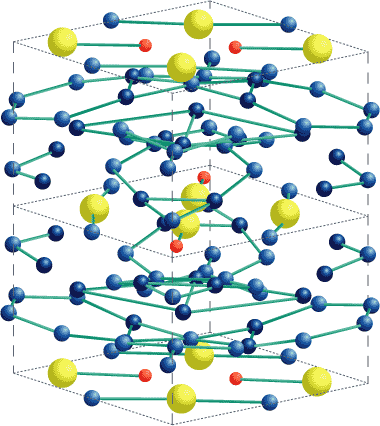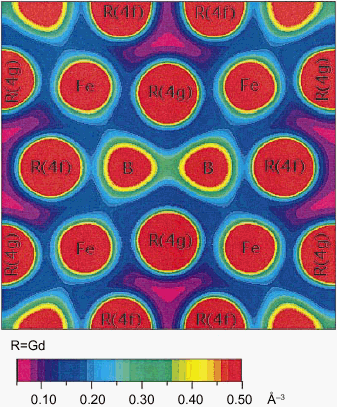Magnetic materials such as that of a strong permanent magnet are very important substances, indispensable as part of the basis for present-day technology. A necessary condition for the magnetic material of a permanent magnet is that it is easily magnetized in a particular direction (i.e., there is strong magnetic anisotropy). However, because transition metals as iron (Fe) which are used as the main constituent of a permanent magnet do not show strong magnetic anisotropy, it is necessary to enhance magnetic anisotropy by mixing rare-earth elements (R) such as neodymium (Nd) (Fig. 7-1).
To design a high quality magnetic material with strong magnetic anisotropy it is very effective to know an accurate value of a parameter Alm which represents the electron distribution in the material. However, it
is very difficult to measure this value experimentally with high accuracy. Theoretically, on the other hand, the value of the parameter is determined from the electron distribution accurately obtained by a quantum-mechanical calculation. But for this purpose enormous computation time is necessary and, accordingly, such a calculation has not been attempted up to now. We calculated an accurate electron distribution of a compound (R2Fe14B) made of rare-earth, transition metal, and boron by employing the FLAPW method (a full-potential linearized augmented plane wave method) for the case with a rare-earth atom (R) of gadolinium (Gd). We confirmed that the theoretically obtained value of the parameter Alm agrees with the experimentally obtained value. By this analysis method, the calculation is carried out by decomposing the computational region into two domains. This method wins wide recognition as a highly accurate method. The electron distribution in the magnetic material is illustrated (Fig. 7-2), which facilitates an understanding of the mechanism for strong magnetic anisotropy.
For the execution of this calculation, the computational time needed on the vector computer VPP was enormous e.g. several weeks for one case and one year for the whole project. Such a computational method which requires extremely long computational time is not necessarily practical at present. However, from the fact that such a calculated result can predict experimental data with high accuracy this calculation has important implications as a forerunner of the "design of materials by computation" which will certainly be practiced in the future. |

